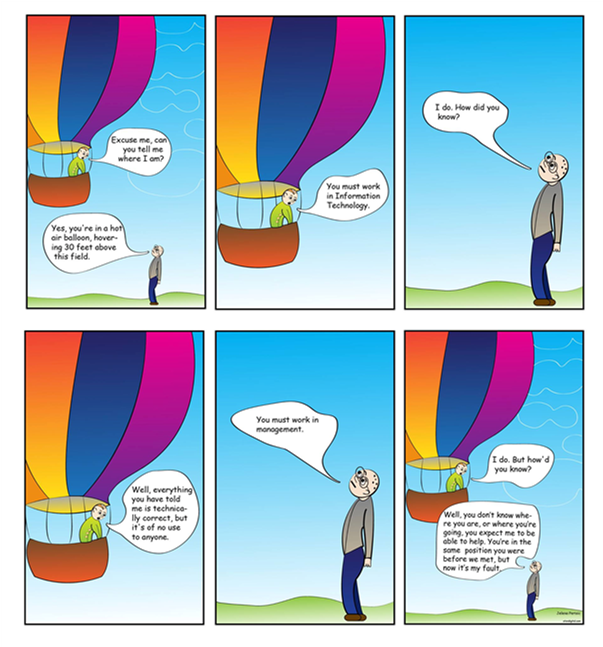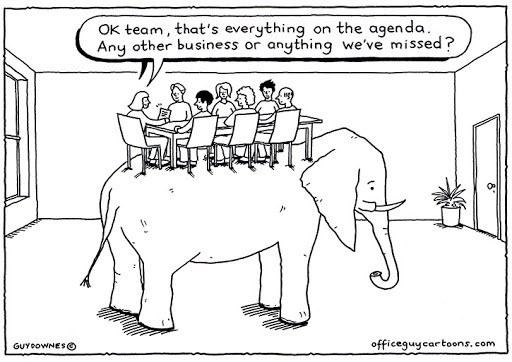Healing the Rift between ICT and Business
Below is a nice little illustration of the rift between ICT and ‘the business’. The term ‘the business’ is regretful, but it further emphasises the extent of the problem. The dilemma also brings to mind parallels with the perceived differences between the natives of Mars and Venus[1].

If only we could see our way to finding the common ground, we’d be so much better off. How often have you heard words to the effect of “isn’t IT supposed to be part of the business”? Have you noticed though, that when it does come together, how effective and empowering it is?
Just as there is growing reason to outsource commodity ICT services to optimise ICT costs/performance, there is value in unifying business and ICT teams to optimise business effectiveness. To start off with, there has to be an admission of responsibility on both sides.
From ICT’s perspective we’ve almost perfected the art of exasperating the business fraternity. Contributing factors include:
- Over-use of jargon as the preferred language of communication, in an endeavour to baffle, confuse, frustrate and above all to maintain distance.
- Putting up barriers (often unintentionally) to thwart attempts by the business to pursue innovative solutions.
- Using restrictive practices to enforce compliance with over-engineered architectures and security regimes.
- Using inadequate User Acceptance Testing (UAT) as the ultimate disclaimer whenever things go wrong.
- Persistent use of incomprehensible diagrams on the premise that ‘a picture paints a thousand words’, even when it may require a thousand minutes to explain it.
Yes, ICT has needs to carry its fair share of responsibility. So, what about the business. Could it be that the business is also culpable? Consider:
- The all too frequent tendency to be blinded by ICT salespeople with their promises of universal remedies, glossy brochures, and the lure of bottomless coffee mugs.
- The obsession with the ‘cloud’ as being the answer to all frustrations if you only disregard matters of security, data privacy, sovereignty, and integration.
- The view that applications are an ICT problem and that most of them should be replaced by cheaper equivalents (i.e. SAP with MYOB or Xero, whilst retaining the functionality and scalability of a big ERP).
- That by only recognising the initial ‘project’ activities for your business, you can ignore the true total costs of ownership, or even better -to pass them off to ICT.
- That by constantly prioritising local business priorities ahead of ‘whole of enterprise’ interests, deflecting the latter to be ICT’s problem.
Yes, maybe the business needs to shoulder some share of responsibility. So, if our intention is to look for genuine improvements, what steps might we take to equalise the situation?
Define a Partnering Charter
Let’s agree on a working charter that clearly set’s out protocols for an effective ‘business partner-like’ approach to ICT. This should incorporate a set of shared goals, KPIs and a clear breakdown of responsibilities (i.e. RACI matrix[1]).
Establish combined ‘Product’ Teams
Assess multi modal approaches and form Product Teams based on targeted growth and improvement areas in the business. Key ICT resources and specialists will work alongside Business Product Leaders and SMEs using iterative, agile and design thinking approaches.
Emphasise outputs and outcomes
ICT people tend to dwell on inputs and processes that are designed to produce outputs and outcomes. The reality is that people are really only interested in the end results and how these might affect them. Much like I’m sure that recent experiences of home schooling under COVID-19 has convinced most of us we just want our kids to have a good education without us needing to review all of the subjects in depth. By focusing on outcomes, Requests for Tender/Proposals can focus on critical requirements specification, leaving vendors to inject value into the transaction.
ICT best practice is like good accounting practice
Its probably taken 40+ years to cultivate good practice in ICT around Service Management, Enterprise Architecture, project management and governance etc. That follows years of systems unreliability, poor business/ICT alignment, project failures and inadequate return on ICT Investments. Don’t sacrifice quality for naïve enthusiasm. Unless good practice is followed, we can expect to return to those bad old days.
The business must take ownership
These are essential components of your business. It is vital that data is clean, accurate and reliable for your business to function properly. Likewise, applications codify your business processes that increasingly determine the effectiveness of your customers’ experience (CX). It makes sense for ‘the business’ to own and control these assets and the whole of life investments in them, including benefits realisation.
Do what’s right for the organisation as a whole
This should be reflected in the Partnering Charter to provide ICT and the business with an obligation to test for best value whenever decisions may have implications enterprise-wide.
So, ‘the Rift’ is probably a classic example of the unspoken ‘elephant in the room’. Why? Well, ICT doesn’t want to be seen to provoke the business and for the business, an unhealthy relationship with ICT sort of validates their view that external vendors do it better. As an independent advisor on ICT matters, I’m happy to set out the challenge to organisations to change their attitudes and make this work – for business sake!

About the Author
Tony Welsh started his ICT career in the UK in retail banking. He moved as a Senior Consultant with LBMS (London) to join KPMG in New Zealand and subsequently to the position of ICT Director (CIO) at Wellington City Council. He moved with his family to Australia in late 1999 to commence as GM Information Services (CIO) for Queensland Rail and he subsequently spent 6 years as CIO for Brisbane City Council (BCC) the then largest Council in the Southern Hemisphere. Tony most recently completed 16 months as the Interim CIO for Ipswich City Council in Queensland.
CIOco is available for short and long term engagements and for advisory services and we can be contacted on +61 407 025 750 or at Tony.Welsh@CIOco.com.au or via our website at https://CIOco.com.au
© 2020 CIOco
[1] A RACI chart is a simple matrix used to assign roles and responsibilities for each task, milestone, or decision on a project.
[2] Men Are from Mars, Women Are from Venus (1992[1]) is a book written by American author and relationship counsellor John Gray
